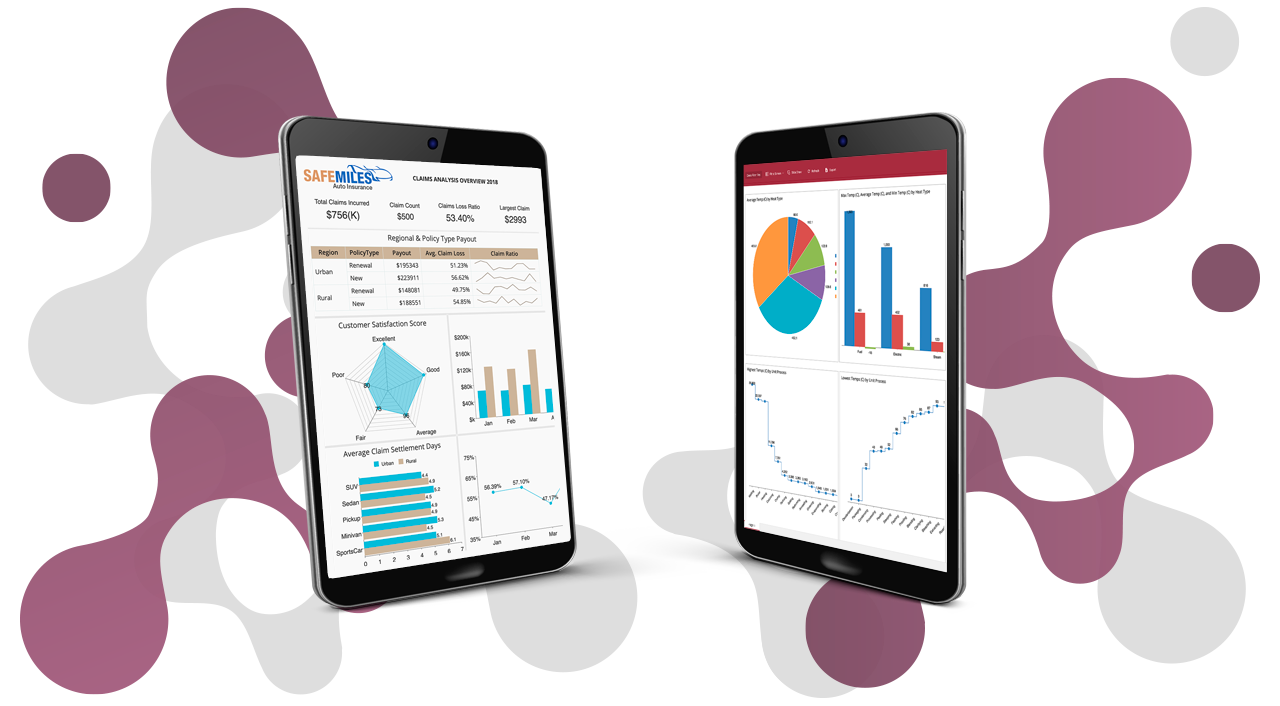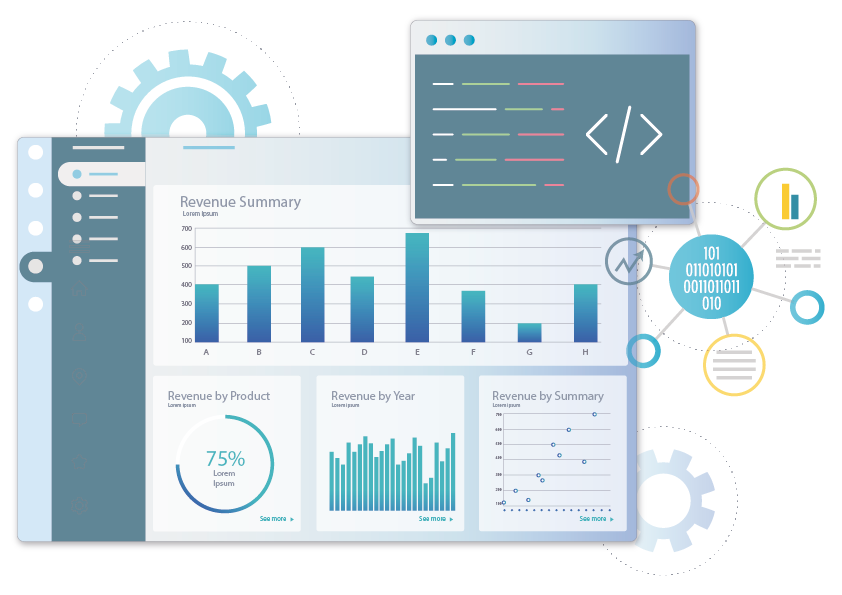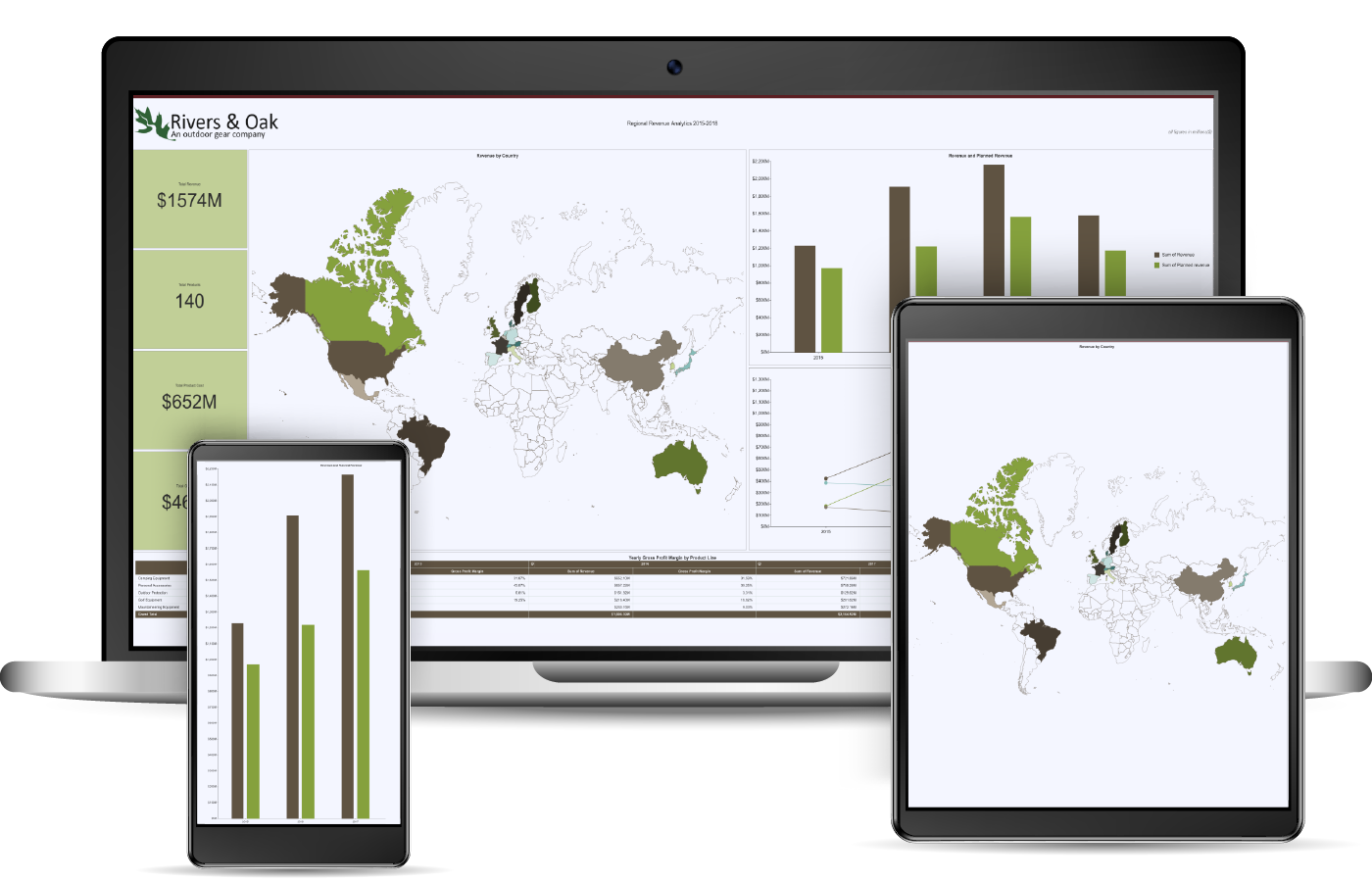Recent studies state that 90% of the world's total data has been generated within the last two years. This has plunged many organizations into an information overload. Often, companies store this data in on-premise databases and spreadsheets. When data exists separately in silos, it's challenging to get a comprehensive (and real-time) insight into your business performance without interrogating multiple reports in separate locations.
When data silos exist, so do multiple versions of the truth, leading to inaccurate intelligence or insights.
What is Embedded BI?
Embedded BI refers to integrating business intelligence tools natively into your software application. Embedded BI tools provide BI reporting, interactive dashboards, scheduling, and distribution tools within your custom apps.
There are many benefits of embedding BI into your application. Embedding BI makes advanced analytics more accessible by directly integrating real-time reports and interactive dashboards into applications users use every day.
Business Intelligence Tools – Buy vs. Build
Analytics and business intelligence features are now firmly established as a "must-have" rather than a "nice to have" functionality across a wide range of software applications. The flow of data to EVERY member of an organization is key to a successful business intelligence strategy. Embedding BI within your software can improve your products, better serve your customers, and impact your business's bottom line. However, not every software provider has sufficient resources to build advanced business intelligence solutions to meet customer demands.
If you plan to add business intelligence features to your software application, several considerations need to be explored, including what capabilities to offer and how best to incorporate them.
If you are an ISV, a system integrator, or a SaaS provider, do you build business intelligence features into your application or buy from a BI vendor?
Here, we'll discuss the four key factors to consider when deciding to build BI into your app or buy from a BI solutions provider.
These considerations are complexity, core business focus, control, and cost.
Understanding the BI space and ongoing knowledge of the industry and best practices.
Understanding the scope of the project and how it relates to your core business and development.
Understanding the needed training, user adoption, roadmaps, and evolution of business intelligence features.
Understanding your total cost of ownership as your app evolves and users grow.
Complexity: Understanding the BI space and ongoing knowledge of the industry and best practices.
Complexity involves understanding and defining the required functionality of the BI feature, developing and integrating the software to incorporate this functionality, and scoping and scaling the resources needed to maintain and evolve the BI capability.
Your focus should be on the end goal and what BI functionality you want to deliver to your customers.
Choosing buy over a build is critical to control the complexity throughout the project's lifetime.
The level of technical knowledge that has gone into developing embeddable BI modules is extensive. If you choose to build your own BI solution, you will need to learn and keep up to date with BI best practices and technology as it evolves.
You also need to examine what functionality you require in your products from the top level down:
- Reports and dashboards
- Only reports
- A limited number of dashboards
- Highly customizable dashboards
- Self-service features
This is technically complex and requires considerable time and resource investment. When you buy a BI solution, you immediately gain access to the years of research, training, and knowledge that your external BI expert has already developed and embodied in the product.
Knowledge of the BI space includes:
- Architectural best practices for BI design and implementation
- Data libraries specific to BI, including learning the detail of new data libraries, data management, and data governance best practices
- Best practices of working with large and aggregated data sets
- Data visualization principles, including graphic design principles specific to BI, and the complexities of interactivity and animations that business users expect
- UI and UX fundamentals that are essential for self-service business intelligence solutions intended for ad hoc reporting, used by customers who are not deeply technical
- Data governance and security best practices
Scope and Cost
Scope and cost can rapidly escalate out of control in custom development. Buying an embedded BI solution can solve this potential issue in several ways:
You will have clearly defined and scoped the project before commencement, and so there should be no implementation surprises that impact project cost and timescales.
Your chosen third-party BI platform supplier will be responsible for implementing and guiding the project with the complexity that it involves.
Beyond the initial implementation, complexity issues include keeping up to date with BI technology and trends (self-service features, AI, predictive analysis, cloud deployment) so that your BI solution does not rapidly become outdated. You must also maintain and develop your BI capability as requirements evolve.
Choosing to buy rather than build approach means that this complexity can be managed as part of your ongoing relationship with your BI platform supplier as they continue to evolve and develop their products.
Focusing on your core business: Understanding the project's scope – does it relate to your core business?
While you know your product best, that doesn't mean you fully understand embedded business intelligence and how to integrate and maintain this feature in your core products effectively.
Your BI approach can impact your entire business, from your product portfolio to your market strategy and differentiation.
Some of the key considerations include:
- Time to market: A custom development is certain to take longer than a buy and embed approach, which can help you get to market quicker with more capability.
- While an embedded solution usually takes 1-3 months to include, custom development can take a year or longer, and delays and complications to the development timeline are likely when expectations and features change.
- While an embedded solution usually takes 1-3 months to include, custom development can take a year or longer, and delays and complications to the development timeline are likely when expectations and features change.
- The learning curve required: When BI is not in your team's core skill set, you would need to invest time and money into getting the team up to speed with the required skills, which can be expensive and lengthen the time taken to deliver on the project. Ongoing learning is then be needed to keep up to speed with the market as it evolves, which again can distract your team from their core responsibilities.
- Dependence upon core individuals: If you choose to buy your BI solution, you are not dependent upon an individual or a small team for something that is not your core business, not just for initial implementation but also for ongoing maintenance and development. Buying an embedded BI solution means you have the supplier's resources at your disposal.
- Project timelines: Project timelines can be volatile when developing software, pushing out project deadlines, delaying product delivery, and reducing the overall return on investment. This will have a run-on negative impact on your core product development activities. Buying rather than building, you can focus on what is core to your business without risking those timelines.
Using BI solutions specifically designed to be embedded, you can enhance your products by providing BI that enables you to improve customer satisfaction and retention while improving the existing core functionality of your application.

The Growing Need for Self-service BI
Self-service BI provides data insights to every employee, even if they don't have a statistical analysis background. Self-service BI has emerged as an alternative for organizations with a small team of data analysts on staff (or no analysts). Any authorized business user can run queries, explore data sets and create their own reports.
If you are building BI into your products, be mindful of self-service UI/UX best practices. Self-service BI is meant for all business users. Self-service UI/UX best practices offer a simple UI and UX, so it's not intimidating to employees who aren't tech-savvy. At the same time, you'll need BI tools that appeal to both casual users (who may only be viewing data) as well as power users who want to create complex dashboards and reports.
Some of the biggest challenges with self-service BI are ensuring security, privacy, and data governance. After all, not all business users have access to the same data, so a self-service model has to consider this. That's where role-based permissions come into play. Role-based permissions are assigned to employees based on their role—so sensitive or confidential information is only accessible to authorized users. Data governance and security best practices must be thoroughly understood and implemented if your development team builds self-service features within your BI solution.
Control and Responsibilities
Control includes several factors across the project's lifetime, far beyond the scope of initial implementation.
Who is responsible for quality assurance, support, and maintenance?
Who will manage product roadmaps and feature evolution? If key the developers of your custom-made software left your company, would your team be able to troubleshoot and maintain the platform easily?
It is essential to consider the ownership of these issues before building your own BI tool.
When you choose to buy rather than build your BI solution, your supplier is responsible for many factors required throughout the solution's lifetime:
- Quality assurance: Your BI supplier brings complex industry expertise and experience, and they will be responsible for assuring the quality of the BI solution ongoing.
- Testing: There will be some time needed for integration, but this will be less than what you would require when building and testing a homegrown solution.
- Support: One of the critical factors here is that you do not want to be dependent upon an individual or a small team for something that is not your core business, not just for initial implementation but also for ongoing maintenance and development. You will need to provide training materials, documentation, and onboarding resources for your customers.
- With a third-party BI solution, training documentation is readily available with the launch of the turnkey BI feature.
- With a third-party BI solution, training documentation is readily available with the launch of the turnkey BI feature.
- Ongoing development: Your supplier will have their own roadmap for their product. You may also add your required features to their future roadmap and product evolution.
The Cost: Understanding Your Total Cost of Ownership
Once you have taken complexity, focusing on your core app, and control into account, there are additional cost factors. If you decide to go with a third-party BI solution, the total cost of ownership must be considered.
The total cost of ownership (TCO) is a term used to describe how much it costs to acquire, operate, and maintain something throughout its lifetime. Rather than just looking at the initial price, TCO includes other expenses that may lurk beneath the surface.
The first step to calculate TCO is to take a holistic view of the BI solution you are considering:
- What are the licensing costs?
- What are the per-user costs?
- How will this solution affect our IT architecture and hardware needs?
- How much training will be required?
- Does the BI solution offer native multi-tenancy?
Find a Scalable BI Tool
Your TCO could be low when you have 50 users, but what will the costs be when users grow and there is an increase in the number of user licenses?
The addition of a single user could double license fees and shatter your budget. This is because many BI platforms use non-linear tiered licensing models that increase dramatically between user tiers.
Wyn Enterprise has a simple and transparent licensing model.
Software providers may embed Wyn Enterprise in an unlimited number of applications with an unlimited number of end-users from a single Wyn licensed server for a flat fee.
Server-based licensing allows you to budget accurately for business intelligence long-term. You can scale your app and the user base with no additional cost.
Buy vs. Build: The Bottom Line
The aim to build from scratch and own every line of code in your product is commendable. However, understanding and addressing the issues of complexity, core focus, control, and cost will help you decide the best approach – to buy or build.
Ultimately, when purchasing embedded BI, the integration roll-out saves time, resources, and costs, allowing for seamless adoption and a much lower end-user learning curve.
Overall cost benefits of an embedded solution include:
- More predictable and manageable TCO
- A great deal of functionality and added value in a shorter time-frame
- Quicker ROI with faster implementation and reduced resource needs
- Higher focus on core business and other opportunities
Finally, with a buy rather than build approach, your application will be more powerful with real-time BI, native data sources, and an ongoing BI roadmap. By focusing on your technology and products, you can continue to innovate and compete in the market with your core offerings.
To learn more about embedded business intelligence for SaaS providers, get in touch. We will provide a custom demo and a free trial where you can evaluate Wyn with your own data and security.































